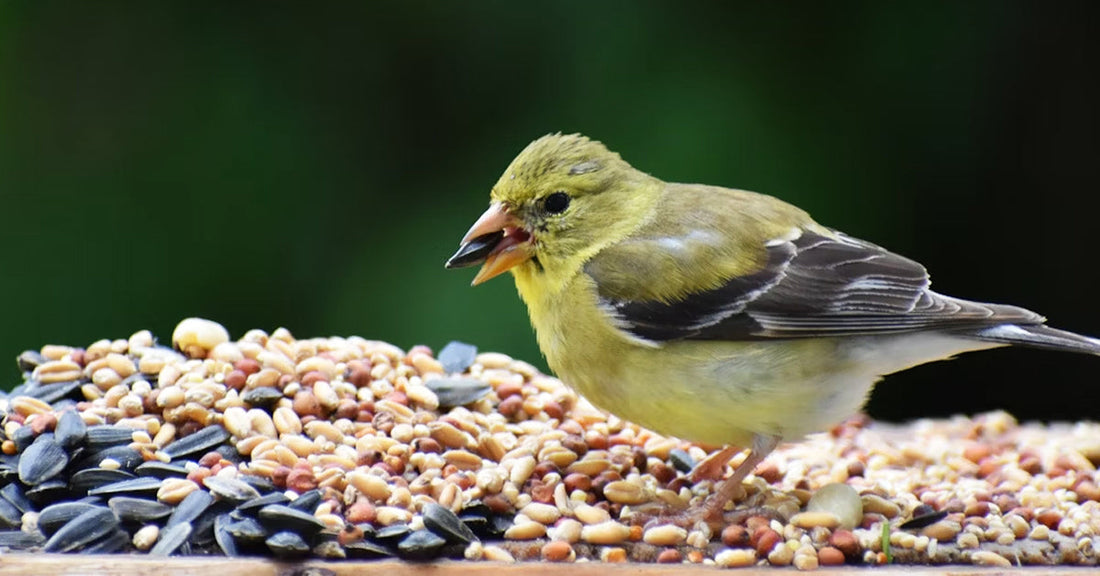
The Ultimate Backyard Bird Feeding Guide: Choosing the Right Seeds for Your Visitors
Share
Not all birds eat the same food—and if you’ve ever wondered why certain species flock to your feeder while others stay away, the answer usually lies in the seed. By offering the right mix, you can attract a wide variety of backyard visitors, from colorful finches to elusive woodpeckers.
Here’s a guide to the most popular bird foods and the species that love them.


Black Oil Sunflower Seeds: The Universal Favorite
If you’re only going to stock one seed, make it black oil sunflower. These seeds have thinner shells than striped sunflower seeds, which makes them easy for both small and large birds to crack. They are also packed with high-fat content, providing essential energy, especially in colder months when natural food is scarce. Their rich oil makes them attractive to a wide variety of species, and they’re less likely to go to waste since most backyard birds readily eat them. This combination of nutrition, accessibility, and versatility is why black oil sunflower seeds are considered the most popular choice among bird enthusiasts.
Birds you’ll attract: Northern Cardinals, Chickadees, House Finches, Nuthatches, Blue Jays.
Nyjer (Thistle) Seeds: Goldfinch Magnets
Tiny, oil-rich nyjer seeds are beloved by small finches. Their lightweight nature requires a special feeder with tiny holes. High in calories and protein, nyjer provides essential energy for active finches during migration and winter months. Because of its fine texture, it discourages larger birds and leaves the feeder to delicate species that truly depend on it.
Birds you’ll attract: American Goldfinches, Pine Siskins, Common Redpolls.
Tip: Replace nyjer often—it spoils faster than other seeds.
Safflower Seeds: For Cardinals, Not Squirrels
Safflower seeds are slightly bitter, which makes them less appealing to squirrels and blackbirds. Cardinals, however, love them. Their thick shells deter nuisance species while catering to birds with stronger beaks. It’s a great alternative if you’re frustrated by starlings or grackles taking over your feeders.
Birds you’ll attract: Northern Cardinals, Grosbeaks, Titmice.
Tip: Perfect if you’re battling squirrels at your feeders.
Millet: Sparrows and Ground Feeders’ Choice
White and red millet are inexpensive seeds that attract ground-feeding birds. Scatter them directly on the ground or offer them in platform feeders. Millet is especially popular among flocking species and winter birds, making it a cost-effective way to welcome larger numbers without breaking the budget.
Birds you’ll attract: Mourning Doves, Juncos, Towhees, Sparrows.
Peanuts: Protein for Larger Birds
White and red millet are inexpensive seeds that attract ground-feeding birds. Scatter them directly on the ground or offer them in platform feeders. Millet is especially popular among flocking species and winter birds, making it a cost-effective way to welcome larger numbers without breaking the budget.
Birds you’ll attract: Blue Jays, Woodpeckers, Titmice, Chickadees.
Tip: Avoid salted or flavored peanuts—plain only!
Suet: Energy for Cold Weather
White and red millet are inexpensive seeds that attract ground-feeding birds. Scatter them directly on the ground or offer them in platform feeders. Millet is especially popular among flocking species and winter birds, making it a cost-effective way to welcome larger numbers without breaking the budget.
Birds you’ll attract: Downy Woodpeckers, Nuthatches, Wrens.
Tip: Offer suet in a cage feeder, especially during colder months.
Nectar and Fruit: For Hummingbirds and Orioles
White and red millet are inexpensive seeds that attract ground-feeding birds. Scatter them directly on the ground or offer them in platform feeders. Millet is especially popular among flocking species and winter birds, making it a cost-effective way to welcome larger numbers without breaking the budget.
Birds you’ll attract: Hummingbirds (nectar), Orioles (orange halves, grape jelly), Catbirds (fruit).
Common Mistakes to Avoid When Feeding Birds
Creating a backyard bird haven takes more than just hanging a feeder. Avoid these common mistakes to keep birds healthy and returning:
- Not replacing seed regularly. Old or spoiled seed can make birds sick. Refresh seed at least every two weeks, and more often during nesting season or if pests get in.
- Placing feeders where pests access them. Keep feeders away from rooflines, decks, or branches that let squirrels or raccoons climb in. A smart bird feeder can help you spot intruders quickly.
- Skipping feeder cleaning. Dirty feeders spread disease. Clean them every time you refill: use a mix of 1 part bleach to 9 parts water, rinse well, and always wash your hands afterward.
- Buying cheap, low-quality seed.Bargain mixes often contain filler grains birds won’t eat. Choose fresh, organic, high-quality seed with clear nutrition labels and no expired stock.
How a Smart Bird Feeder Helps
Keeping track of what birds visit your backyard—and what they prefer—can be tricky. That’s where the Pawmendous Smart Bird Feeder with Camera comes in:
- See every visitor up close with HD images and videos.
- Identify species instantly with built-in AI recognition.
- Track feeding patterns over time to learn which seeds work best.
- Share your sightings with friends and fellow birders online.
👉 Order the Pawmendous Smart Bird Feeder today and transform your backyard into a bird haven.

Final Thoughts
Bird feeding isn’t just about filling a feeder—it’s about creating a welcoming habitat for your feathered neighbors. By choosing the right seeds, you’ll enjoy greater variety, healthier birds, and unforgettable backyard moments.
Start experimenting today, and let your yard become the favorite stop on the block.
References
- National Audubon Society – Who Likes What: A Guide to Favorite Birdseed for Feeder Regulars and Rarities
- Cornell Lab of Ornithology – Feeding Birds
- American Birding Association – Beginner’s Guide to Bird Feeding
